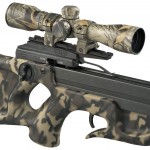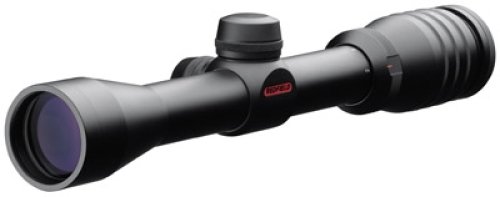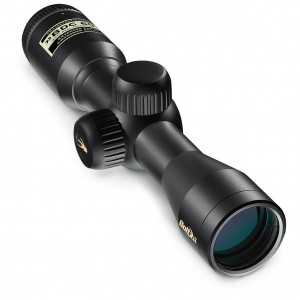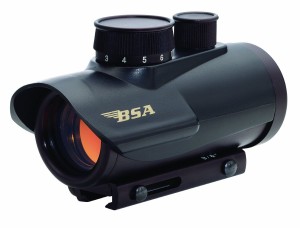Most crossbows come with some sort of scope these days, so examining the scope you’re getting with your crossbow is just as important as examining the crossbow itself. Of course, many crossbow archers like to upgrade their scopes, so examining a third-party model is important, too. We’ve reviewed a number of crossbow scopes, and would like to provide you with this guide to understanding what to look for when you are shopping for the perfect one to go along with your crossbow.
The Best Crossbow Scopes & Reviews
Types of Scopes
The first thing to know is what type of scope you are looking for. Generally, crossbow scopes will fall into two broad categories: optic scopes and red dot scopes. Each has its purpose, and each has both shortcomings and advantages in crossbow archery and hunting.
Red Dot Scopes
The most basic type of scope you can find is the red dot scope. This type of scope typically does not have any magnification, and is just a slight step up from an open sight. With a red dot scope, you get a dot, usually red but sometimes green, superimposed on your sight image. Where the dot lies is where your shot should hit, assuming you have your red dot scope properly sighted in and you are at the correct range.
When looking at a red dot scope, look for multiple brightness settings. In darker lighting, you would want the red dot to be dimmer, so as to avoid a “halo” or “ghost” effect around the dot. The haloing or ghosting that can occur with high brightness settings in low light can throw off your accuracy.
Some red dot scopes will have multiple dots, allowing you to sight in your scope at different ranges and use different dots for those ranges. If you shoot from a variety of different ranges, having multiple dots can be a definite advantage.
Optic Scopes
Optic scopes are very similar to what you see on rifles, and often (but not always) offer some form of magnification. Optic scopes can have a single crosshair reticle, but more common in crossbow scopes is the multi-reticle option, providing you with multiple reticles for use with different ranges. There are also illuminated varieties of optic scopes, which allow you to use the scope more effectively in low light conditions.
Now that you understand the basic types of scopes, we can move on to the things you should look at and for when shopping for a new scope, or evaluating the scope that comes with that pretty new crossbow you want to buy.
Magnification
Magnification is often important when shooting a crossbow, because it helps to bring the view of the target closer to you. The amount of magnification you get from a scope directly affects how accurately you can shoot your crossbow from longer ranges. The more powerful your crossbow, the more powerful magnification you should look for. The most commonly-found magnifications on crossbow scopes is 3X, which will typically allow a good shot to maintain accuracy out to 50-60 yards. If your crossbow is powerful enough to reliably shoot at longer ranges without too much drop-off, however, you might look for a scope that will provide magnification in the 4X or 5X range.
Parallax
Parallax is the apparent movement of objects within the field of view in relationship to the reticle. Not setting the parallax properly can result in a scope that doesn’t sight in accurately or allows too many sighting errors. This is not really much of a factor with crossbow scopes, because the amount of parallax in lower magnification scopes like those used with crossbows is so small as to have very little importance in fast, accurate target acquisition. Still, if you are choosing a third-party scope, such as a Leupold scope, you will want to make sure the parallax is easily adjustable to the range you expect to do the majority of your shooting from. Avoid high-magnification scopes with the parallax set only for rifle shooting, because this parallax will often not be compatible with the type of shooting a crossbow archer tends to do.
Optics Quality
The next characteristic to look at in a scope is the optics quality. The quality of the optics, as well as the quality of the optics coating, greatly affects how crisp and clear your target sight is. It doesn’t matter how much magnification you have, if the image doesn’t focus quickly and easily into a crisp, clear target, you will see serious accuracy issues. Examine the scope as carefully as you can, looking through the scope to see what the image quality is like. Many retailers will actually have special viewing areas or images set up just for this purpose; make use of them! Be sure that your scope gives you a clean and accurate image of your target, so you can be sure of proper shot placement when you use the scope for target shooting or hunting.
The quality of the optics coating is also a huge factor in what makes for a great scope, especially for hunters. Colder temperatures can often result in optics getting foggy, and the quality of the coating on the optics should prevent that fogging from happening. This is more difficult to test in the store, so you should read up on the scope by reading reviews of the scope. Our scope reviews always include information about the fog-resistance of the scope, so pay careful attention to that information.
Light Gathering Capability
Next up is light gathering capability. Let’s face it, the critters we’re hunting for don’t always keep the same hours that we do, so we often find ourselves hunting just before dawn or just after sunset. The ability of the scope to gather light and use it to create a good target image is crucial in these conditions, but how the scope handles light in the middle of the day is important, too.
Your scope should be able to present you with not only a clear and crisp target, but also one that is richly contrasted. Since animals are often equipped with natural camouflage, contrast is vital in picking out the target, and determining where the target’s vital organs should be located. The ability (or inability) of the scope to make the best possible use of the available light will impact contrast heavily, so look for a scope that has excellent light gathering capabilities.
For illuminated scopes, make sure the brightness settings are adjustable. This is usually accomplished with a rheostat, and you should make sure the illuminated reticle or dot is going to be just bright enough to see in the lowest light conditions, without causing rings or haloes around the reticle or dot.
Field of View
Now we get to the field of view, which is the amount of terrain that will be visible from a particular range. This is usually expressed in terms of the number of feet or meters at 50 or 100 yards, such as 33 feet at 50 yards. The field of view is important because it determines how easy it will be to locate your target in the scope. You should look for a healthy balance of the scope’s magnification and its field of view, as well as proper parallax settings on the scope itself. The more terrain you can see in the scope at maximum magnification, the faster you’ll be able to acquire your target.
You should avoid scopes that have extremely limited fields of view, usually caused by the barrel being too thin. Instead, look for a good scope with at least a 30mm barrel for a 3X scope, which should give you at least 35 feet of view at 100 yards.
Mounting the Scope
Once you’ve examined the qualities of the scope itself, you should look at how easy it is going to be to use the scope with your crossbow. Some scopes come with rings, some do not, so it is important to know beforehand if you need to purchase a set of rings for mounting your scope to your crossbow. The rings should tighten firmly to the scope and the rail, without allowing any movement along any axis. For example, the scope should not be able to slide back and forth in the rings, or wobble around. It should also attach properly to the scope’s rail without any movement forward, backward, or from side to side.
Sighting in the Scope
Finally, you should look at how easy the scope is to sight in and stay sighted in. The standard sight adjustment for elevation and windage will move the shot ¼” for every click (at 20 yards), so look for a scope that sticks with this formula. You should avoid scopes that have difficult-to-access or difficult-to-use windage and elevation knobs, or windage/elevation knobs that fall off too easily.
A good quality crossbow scope should sight in within 6 shots, for a skilled archer, and should stay sighted in throughout at least the entire hunting or archery season. Storage, as well as removing and replacing the scope, can often affect the accuracy of the scope, but a scope that remains attached to the crossbow should stay sighted in, even after several weeks of use and transportation.
Best Crossbow Scopes – Summary
So, there you have it. Everything you always wanted to know about shopping for a crossbow scope, but might have been afraid to ask. With this information in hand, you can read scope reviews and know what to look for and how to interpret the information in the review. You’ll also know what questions to ask at your local store when you are browsing their selection of crossbow scopes.





Recent Comments